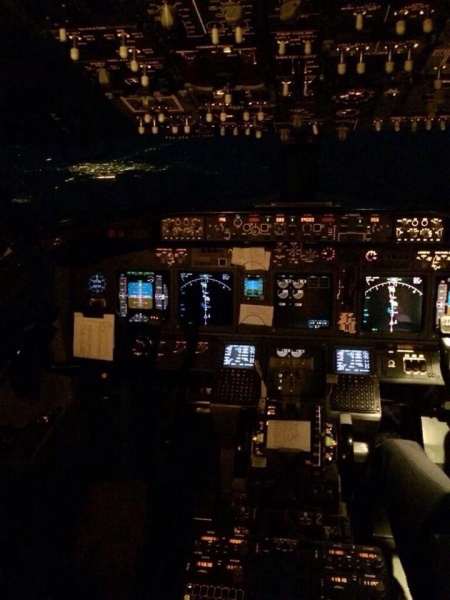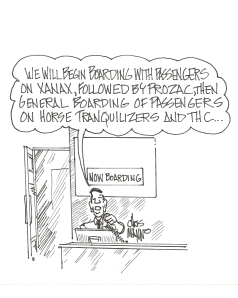Your Pilot Isn’t Thinking About Your Connection–and That’s Good.
There’s a blessed silence in the cockpit right before pushback, immediately after the number one flight attendant reports “cabin ready,” and slams the cockpit door securely shut. Before that, the usual boarding chaos filters through the open cockpit door, the clatter of catering the forward galley, ramp workers stepping in to deliver some cargo paperwork, maybe some aircraft maintenance techs wrapping up required service or repairs.
But the noise and activity isn’t all that ends with the door slam. We call it “sterile cockpit,” an industry-wide concept rooted in the best Crew Resource Management (CRM) practices that dictates all non-flight essential conversation ceases in order to focus solely on the prescribed, often complex procedures required to fly the jet.
In other words, leave all distractions behind and keep your head in the game. And I take that concept a step further–I clear my mind of everything except procedures (there are a multitude) and situational awareness: he’s moving, we’ll wait … wingtip clearance here … wind shift, at least for now … we’re heavier than planned.
Not just sterile cockpit verbally, but mentally as well. When you’re moving eighty tons of metal and a hundred sixty warm bodies, there’s no room for distraction. My airline (like most, I assume) has done a good job of minimizing outside considerations through the basic premises from which the pilot-in-command operates.
For me that means I’ve “pre-worried” about the extraneous considerations–both yours and mine–and for the good of all, I’ve put them aside, compartmentalized them, and now look beyond them. When I say yours, I mean your down line connection, your time schedule, your reason for flying whether business or pleasure. Mine often overlap yours–my days off, my family plans, my important events, even my own physical stress of time zone shifts, late hours that could creep later, and my pay considerations.
Doesn’t mean these concerns are invalid, unimportant or dismissed–they’re just not on my mind as I balance crucial flight variables as they unfold. They’re fully addressed in the basic premises of our airline operation, stipulated in a hierarchy a passenger might not like, but which makes the most sense for a safe flight operation:
First, safety, second, passenger comfort and third, schedule. Yes, your connection, even your arrival time, is in third place. Just remember, I have similar personal concerns and I’m putting them completely aside as well. Here’s why.
A recent Flight Safety Institute report highlighted one of the factors that contributes to the comparatively high accident rate per flight hour experienced by air ambulance operators. One factor mentioned was the very real life or death pressure perceived by the pilots: if we don’t land on this spot, at this time, regardless of circumstances, a life may be lost.
That’s a very vivid and understandable urgency that would be difficult to put out of a pilot’s awareness. Nonetheless, the air ambulance operators with the lowest accident rates are the ones who’ve put CRM at the forefront, refocusing on flight safety limitations as a governing principle and setting aside all else.
Now, your kid’s birthday, your business or other event, yes, they’re important–so are mine. But they aren’t life or death, are they? But as flight distractions, whether it’s an air ambulance or an air carrier, they could easily become exactly that.
From the moment we push back, the clock in my captain’s mind runs on weight, not minutes: how many pounds of fuel do I have, which translates into the ability to remain aloft. So, when you (or maybe a commuting crewmember, to be fair, asks “can we fly faster to make up time,” the real question in my mind is “can we afford to gamble by shortening our available fuel duration, and to what purpose and at what cost?” Less holding time available at our destination, maybe requiring a more stressful approach? No way.
 The answer to “purpose” would be to shave off 5 to 10 minutes–hardly worth it–at the price of degrading our ability to arrival delays because of an increased fuel burn for speed. The question “can we top this weather rather than circumnavigating the area to save time” brings the opposite answer: maybe, but the more prudent option is to avoid–so we’ll spend the extra time (sorry about your connection–and mine) to do that.
The answer to “purpose” would be to shave off 5 to 10 minutes–hardly worth it–at the price of degrading our ability to arrival delays because of an increased fuel burn for speed. The question “can we top this weather rather than circumnavigating the area to save time” brings the opposite answer: maybe, but the more prudent option is to avoid–so we’ll spend the extra time (sorry about your connection–and mine) to do that.
And if you think we as pilots don’t have crucial connections, think again: besides losing pay in a misconnect, there’s more. For many crewmembers, even a ten minute late arrival can mean the difference between getting home or spending a night in a hotel at their own expense and losing a day with family. Sure, I eliminate that worry by not commuting, but crew base positions are determined by seniority–junior pilots and flight attendants can report to work and receive the official notice, “as of next month, you are based a thousand miles from home.”
That all needs to wait outside the cockpit door. Inside, we must focus on the vital flight considerations that trump all distractions.
Again, arrival time–and connections–hang in the balance, but that’s a distant third place behind safety. So yes, I’m not thinking about your connection–and you should be glad. Because that’s exactly what you’ve paid me for, and you deserve no less than the safest, most professional flight, no matter how long that takes.
Fly the jet firsthand:  These 25 short essays in the best tradition of JetHead put YOU in the cockpit and at the controls of the jet.
These 25 short essays in the best tradition of JetHead put YOU in the cockpit and at the controls of the jet.
Some you’ve read here, many have yet to appear and the last essay, unpublished and several years in the writing, I consider to be my best writing effort yet.
Own a piece of JetHead, from Amazon Books and also on Kindle.





November 7, 2014 at 10:58 am
Nicely worded Chris. Nice job! Also how much do you get paid.
November 7, 2014 at 11:10 am
How much do I get paid? Post your email address and I’ll send you a copy of my last Income Tax Return. Or maybe not.
November 7, 2014 at 12:29 pm
isaihdavis422@gmail.com
November 7, 2014 at 12:34 pm
Seriously? You think I’d send my tax return, much less discuss my paycheck, with a complete stranger?
June 17, 2015 at 3:25 pm
> How much do I get paid?
Likely, not enough (even before prior pay cuts), relative to “value added” into the entire value proposition of air transportation’s value chain.
Other numeric questions interest me far more:
What’s the ratio of senior pilot pay to the aircraft’s depreciated (book) value?
Also, what’s the ratio of senior pilot pay to post-crash insurance payouts, funerals, equipment replacement, NTSB investigations, etc?
Or what’s the ratio of senior pilot pay to the total training investment the employer’s made into pilot competence?
Seems to me a single pilot’s pay is “Just a Nit” in the overall budget.
June 18, 2015 at 8:20 am
You may find abstract comparisons interesting, but “how much do I get paid” is most important from a pilot standpoint.
November 7, 2014 at 11:57 am
Yeah, that “how much do you get paid” is an odd question at best. In the glory days (15-20 yrs ago), as an example, for a 747-400 captain on United was probably around $250-$300K. It takes many years to get into that position.
As I hear it, pay has since been going down on even the large carriers such as United and American, but hopefully not too far — we still need the best of the best in situations where a single mistake can erase the existence of 150+ people.
The pay goes down substantially for smaller regional airlines. But I know people who would fly even if they were paid minimum wage.
June 17, 2015 at 3:32 pm
> a single mistake can erase the existence of 150+ people.
Single mistakes don’t produce fatal failures. Commercial air transportation (in developed countries) requires so many “fail-safe” policies, procedures, personnel and products that any one failure isn’t sufficient to cause catastrophe.
Only a series of interdependent failures can cause accidents.
Read some investigation reports from the USA “National Transportation Safety Board” (NTSB) or UK “Air Accidents Investigation Board” (AAIB),.
Among those I’ve seen, there’s always a series of enabling anomalies that cumulatively enable the accident to occur.
June 18, 2015 at 8:18 am
I don’t agree. Usually, there is a chain of events that contains many elements. But that doesn’t preclude a single failure–like a pilot error–from causing an accident.
November 7, 2014 at 1:56 pm
Man you get the questions here Chris.
You are a lot more diplomatic than I am.
I have been letting my “inner curmudgeon”run free last few years.
Never had a problem with the pilot delaying the departure because of weather, landing at at alternate…
I suppose there are passengers that think they are simply flying in an aluminum tube and get highly agitated with any diversion from the norm.
But I have always felt that the guy in the left seat values his life and we are along for the ride 😉
BTW I am amazed at the roles the 737 has taken in the last few years – used to be used only for short hops –
November 7, 2014 at 3:53 pm
Well done Chris!!
November 7, 2014 at 4:02 pm
[…] the life of an airline pilot, travel. You can follow any responses to this entry through the RSS 2.0 feed. You can leave a response, or trackback from your own […]
November 7, 2014 at 4:49 pm
Thank you for another great post, Chris. Your airline’s Contract of Carriage and those of every other Part 121 carrier, have pages of legalese that say little more than the nod that constitutes our personal contract: I pay and you fly to the best of your ability. That sir, is all I ask. Comfort? I prefer smooth flights, but moderate bumps to not bother me. Good catering and cabin service (when they happen) are appreciated, but not my priority. My personal schedule and connections are also important, but I usually have plans B, C, and D. When I’m riding on your airplane, reaching OUR destination safely is my sole concern and I recognize that we share this wish. The rest is trivial. We’re both riding the same airplane and unless some ‘transporter’ beams us in different directions, we will arrive at in the same place and at the same time. you have my unqualified support.
As I recall from Driver’s Training and Applied Algebra classes about fifty years ago, that tiny increase in speed is wasteful, often dangerous and of little real value. I believe the Sterile Cockpit and CRM practices, as most professionals practice them, are worth while. Professional behavior on your side of that vault door enjoys my unqualified support. Despite the odd inconvenience or business disagreement, if you arrive safely, so will I. As noted before, perhaps that’s why they call you Captain. Regards, -CG
November 7, 2014 at 9:28 pm
Somehow I don’t see Chris doing this:
http://abc7chicago.com/weather/major-delays-for-flights-coming-into-ohare-due-to-weather/383798/
November 8, 2014 at 7:32 am
Actually, that’s a decent landing in high crosswinds.
November 9, 2014 at 8:23 am
No, it’s not a decent landing: if you can’t eliminate the crab by touchdown, you don’t have the rudder authority to control the jet on the high-speed part of the landing roll. Worse, you side load the landing gear on touchdown, and risk dragging an engine pod on the runway. That crosswind was either too excessive, or the cross controls were not properly done. The Boeing jets are built very sturdy, but sideloading the main landing gear is a recipe for disaster. The Fokker-100 flight manual warned that landing in such a crab could shatter a main gear strut. The video depicts an awful landing that never should have been done–especially at O’Hare where there are many more runway options that would result in less crosswind.
November 10, 2014 at 11:16 am
But how hilarious, or awkward, would it have been had I replied, “I did that. It was me landing the plane.” 😉 I didn’t of course. I’m just an aviation enthusiast/wanna be pilot.
November 10, 2014 at 11:21 am
I cringe at a lot of things I see other pilots do. If it had been you, and I’d seen it happen, I’d have discussed it with you via our Professional Standards people. It wouldn’t be hilarious.
November 8, 2014 at 3:35 am
As always your post so well written and informative. Also, I’m very much enjoying your book dipping in as and when to prolong the pleasure. LSP
November 14, 2014 at 11:37 pm
I’ve read reports of pilots using slower cruise speeds to save fuel, even if they arrive slightly later. I’ve never heard a pilot mention doing this, just wondering if there was any truth to it.
November 15, 2014 at 5:49 am
Maybe. But I don’t know anyone who would do so at the expense of schedule. The cruise Mach is planned at the most economical speed; not sure why anyone would fly slower, which wouldn’t save fuel.
June 17, 2015 at 3:12 pm
I’ve heard “All TAKEOFFs are OPTIONAL All LANDINGS are MANDATORY.”
Based *solely* on the headline, I’m glad to discover my pilots are more concerned with THIS LANDING rather than considering the NEXT TAKEOFF.
June 17, 2015 at 3:19 pm
Daddy used to say “Don’t Be In Such A Hurry To Get To The Accident.”
He also said “Takes longer to ‘Get There’ after a detour to ‘The Hospital’ (or ‘The Morgue’).”
Never new dad went to flight school.